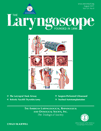Abstract
Varicella zoster virus (VZV) infection of the head and neck region may present with various clinical symptoms, involving different entities and different routes of viral spreading. We present a case of VZV infection of the pharynx and larynx with multiple cranial nerve (CN) neuropathies (CN VII, VIII, IX, and X) of a 52-year-old woman who complained of the sudden onset of hoarseness, odynophagia, dysphagia, and hearing loss in the left ear, followed by left-side facial weakness lasting for 1 week. Endoscopic examination revealed multiple mucosal erosions over the oropharynx, with extension upward to the nasopharynx and downward to the mucosa overlying the epiglottis, arytenoid, and vocal cord. All of these lesions tended to lateralize to the left side, suggesting a VZV infection diagnosis; this was confirmed by polymerase chain reaction on eruptional exudates, as well as serologic examination.




